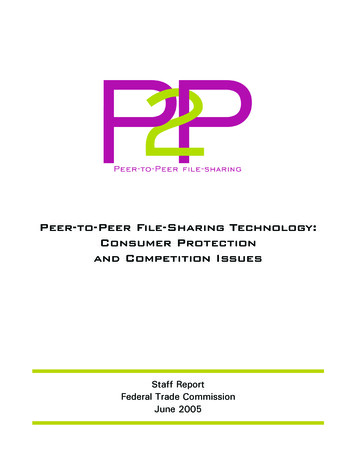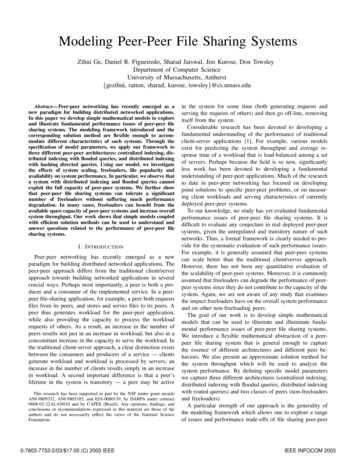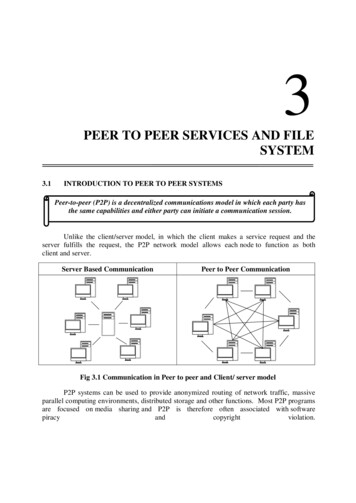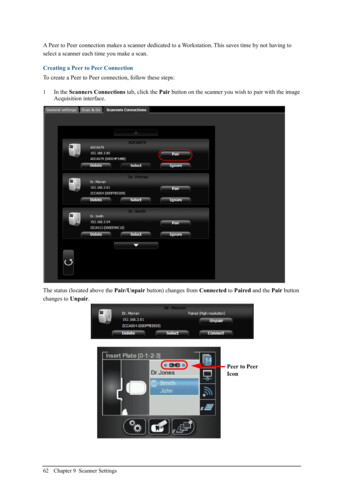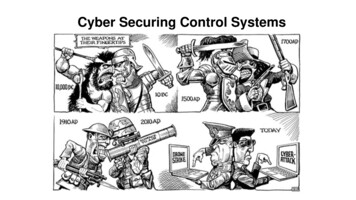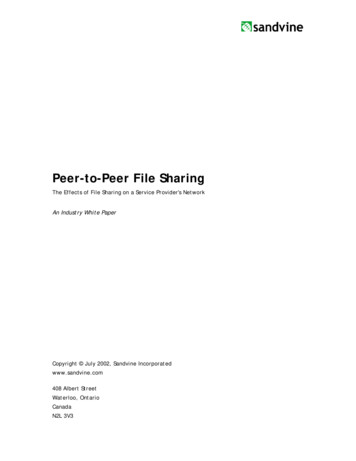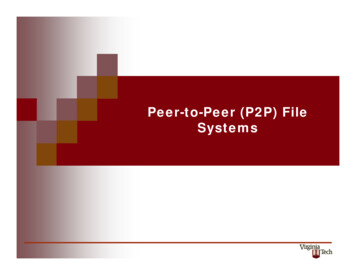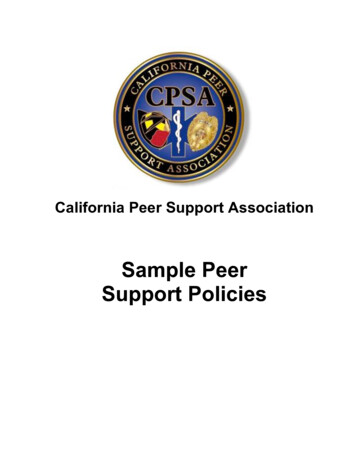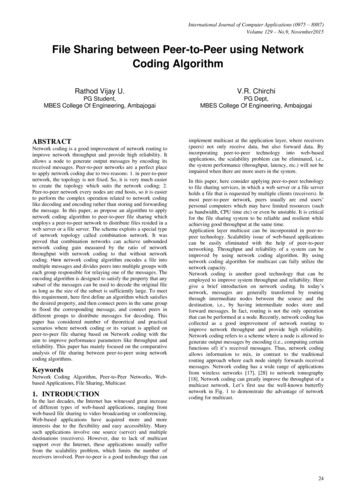
Transcription
International Journal of Computer Applications (0975 – 8887)Volume 129 – No.9, November2015File Sharing between Peer-to-Peer using NetworkCoding AlgorithmRathod Vijay U.V.R. ChirchiPG Student,MBES College Of Engineering, AmbajogaiPG Dept,MBES College Of Engineering, AmbajogaiABSTRACTNetwork coding is a good improvement of network routing toimprove network throughput and provide high reliability. Itallows a node to generate output messages by encoding itsreceived messages. Peer-to-peer networks are a perfect placeto apply network coding due to two reasons: 1. in peer-to-peernetwork, the topology is not fixed. So, it is very much easierto create the topology which suits the network coding; 2.Peer-to-peer network every nodes are end hosts, so it is easierto perform the complex operation related to network codinglike decoding and encoding rather than storing and forwardingthe message. In this paper, as propose an algorithm to applynetwork coding algorithm to peer-to-peer file sharing whichemploys a peer-to-peer network to distribute files resided in aweb server or a file server. The scheme exploits a special typeof network topology called combination network. It wasproved that combination networks can achieve unboundednetwork coding gain measured by the ratio of networkthroughput with network coding to that without networkcoding. Here network coding algorithm encodes a file intomultiple messages and divides peers into multiple groups witheach group responsible for relaying one of the messages. Theencoding algorithm is designed to satisfy the property that anysubset of the messages can be used to decode the original fileas long as the size of the subset is sufficiently large. To meetthis requirement, here first define an algorithm which satisfiesthe desired property, and then connect peers in the same groupto flood the corresponding message, and connect peers indifferent groups to distribute messages for decoding. Thispaper has considered number of theoretical and practicalscenarios where network coding or its variant is applied onpeer-to-peer file sharing based on Network coding with theaim to improve performance parameters like throughput andreliability. This paper has mainly focused on the comparativeanalysis of file sharing between peer-to-peer using networkcoding algorithms.KeywordsNetwork Coding Algorithm, Peer-to-Peer Networks, Webbased Applications, File Sharing, Multicast1. INTRODUCTIONIn the last decades, the Internet has witnessed great increaseof different types of web-based applications, ranging fromweb-based file sharing to video broadcasting or conferencing.Web-based applications have acquired more and moreinterests due to the flexibility and easy accessibility. Manysuch applications involve one source (server) and multipledestinations (receivers). However, due to lack of multicastsupport over the Internet, these applications usually sufferfrom the scalability problem, which limits the number ofreceivers involved. Peer-to-peer is a good technology that canimplement multicast at the application layer, where receivers(peers) not only receive data, but also forward data. Byincorporating peer-to-peer technology into web-basedapplications, the scalability problem can be eliminated, i.e.,the system performance (throughput, latency, etc.) will not beimpaired when there are more users in the system.In this paper, here consider applying peer-to-peer technologyto file sharing services, in which a web server or a file serverholds a file that is requested by multiple clients (receivers). Inmost peer-to-peer network, peers usually are end users’personal computers which may have limited resources (suchas bandwidth, CPU time etc) or even be unstable. It is criticalfor the file sharing system to be reliable and resilient whileachieving good throughput at the same time.Application layer multicast can be incorporated in peer-topeer technology. Scalability issue of web-based applicationscan be easily eliminated with the help of peer-to-peernetworking. Throughput and reliability of a system can beimproved by using network coding algorithm. By usingnetwork coding algorithm for multicast can fully utilize thenetwork capacity.Network coding is another good technology that can beemployed to improve system throughput and reliability. Heregive a brief introduction on network coding. In today’snetwork, messages are generally transferred by routingthrough intermediate nodes between the source and thedestination, i.e., by having intermediate nodes store andforward messages. In fact, routing is not the only operationthat can be performed at a node. Recently, network coding hascollected as a good improvement of network routing toimprove network throughput and provide high reliability.Network coding refers to a scheme where a node is allowed togenerate output messages by encoding (i.e., computing certainfunctions of) it’s received messages. Thus, network codingallows information to mix, in contrast to the traditionalrouting approach where each node simply forwards receivedmessages. Network coding has a wide range of applicationsfrom wireless networks [17], [28] to network tomography[18]. Network coding can greatly improve the throughput of amulticast network. Let’s first use the well-known butterflynetwork in Fig. 1 to demonstrate the advantage of networkcoding for multicast.24
International Journal of Computer Applications (0975 – 8887)Volume 129 – No.9, November2015coding (Li and Yeung, 2006) and so on. Among them, one ofthe most fundamental and widely used coding methods islinear network coding, where packets are linearly combined atintermediate node. Introduced in 2003, linear network codingalways suffices to achieve the theoretical maximumthroughput for multicast sessions (Li et al, 2003).This paper is organized as follows: In section II, LiteratureReview of paper. In section III, Explained Proposed System.In section IV, Advantages of Proposed Algorithm and insection V and VI, future work and conclusion respectively.Fig 1: Illustration of the advantage of network coding formulticast. (a) The butterfly network represented by aDAG. (b) Multicast without network coding. (c) Multicastwith network coding [1].In the figure, node s is the source, nodes r1 and r2 are tworeceivers, all edges have capacity 1, which means that theedge can only transmit 1 unit of data (bit) per unit time(second), and source s has two bits, b1 and b2 to multicast toboth r1and r2. First we use the traditional multicast withoutnetwork coding as shown in Fig. 1(b). Without loss ofgenerality, we use the dashed line (red) to represent bit b1, thedotted line (blue) to represent bit b2 and the bold line (green)to represent both bits b1 and b2. Bit b1 can reach r1 in twoseconds, and bit b2 can reach r2 in two seconds. When node creceives both bits, it forwards them in sequence. Suppose itforwards bit b1 first. Then r1 receives both bits in 4 secondsand r2 receives both bits in 5 seconds. Now consider usingnetwork coding on link c–d as shown in Fig. 1(c). When nodec receives both bits, it first mixes them by performing anexclusive OR (XOR) operation. Then it sends the mixed bit bto d node. When nodes r1 or r2 receive the mixed bit, it canrecover the original bits b1 and b2 by XO-Ring the mixed bitand the other received bit. The entire transmission can becompleted in 4 seconds. The definition of link c to dthroughput (γ) from node c to d is given by2. LITERATURE REVIEWNumbers of network coding scheme have been proposed inpast for multicast networks some are explaining as follows: 2000: Concept introduced: In a landmark paper,Rudolf Ahlswede, Ning CAI, Shuo-Yen Robert Liand Raymond W. Yeung showed the potentialpower of network coding in multicast networks,where all receivers get identical information. Theyproved that good (informative) codes exist, althoughthey did not describe a method for designing them[2]. 2002: Another important performance parameter isthe security of the network. CAI and Yeungconsidered the problem of using network coding toachieve perfect information security against a wiretapper who can eavesdrop on a limited number ofnetwork links, and presented the construction of asecure linear network code for this purpose [30]. 2003: Important steps taken toward practicalimplementation. Li, Yeung and CAI showednetwork coding for multicast networks can rely onmathematical functions involving only addition andmultiplication, which reduces the complexity ofdesigning codes. And two of us (Koetter andMédard) introduced a powerful algebraicframework for analyzing coding approaches andsimplifying code design [3] [4]. 2005-2006: Valuable design algorithms published.Sidharth Jaggi, then at Caltech, with Peter Sandersof the University of Karlsruhe in Germany, one ofus (Effros) and collaborators and, separately, TraceyHo of Caltech, with the three of us and others,published low-complexity algorithms for designingthe functions used by each node in a multicastnetwork. The first paper gave a systematic approachfor designing functions; the second showed thatchoosing functions randomly and independently foreach node should work just as well[6][7]. 2005: One important performance parameter is thenetwork cost incurred for a given set of connections,and the complexity associated with the computationof the sub graphs needed to provide the connections.While the minimum cost multicast problem inrouted networks requires the finding of a directedSteiner tree, which is NP-hard, the same problem incoded networks can be solved by a linear programin polynomial time and also be implemented in adecentralized manner [15]. 2006: Applications for wireless networks explored.D.M.Chiu, R.W.Yeung, J.Huang, and B.Fan,γ Number of bits from node c to node dObservation durationPeer-to-peer (overlay) networks are a perfect place to applynetwork coding algorithm due to two reasons: 1. in peer-topeer network, the topology is not fixed. So, it is very mucheasier to create the topology which suits the network coding;2. Peer-to-peer network every nodes are end hosts, so it iseasier to perform the complex operation related to networkcoding algorithm like decoding and encoding rather thanstoring and forwarding the message[1].Network coding can be viewed as a generalized routingscheme and can be applied to any types of routing, i.e. uncast,multicast and broadcast, to enable a more efficient datatransmission.There are two main streams of research in the field of networkcoding. One stream investigates efficient encoding-anddecoding algorithms to increase the data transmission ratewhile reducing the computational cost and the otheremphasizes the applications of network coding.For the first stream, regarding the encoding functions tocombine the received information at intermediate nodes, therehave been a number of encoding-and-decoding algorithms,e.g. linear network coding (Li et al, 2003), algebraic networkcoding (Koetter and Médard, 2003), convolution network25
International Journal of Computer Applications (0975 – 8887)Volume 129 – No.9, November2015demonstrated the potential benefits of networkcoding for wireless applications and characterizedscenarios in which the approach would beparticularly helpful [13]. 2014: It applies linear network coding to peer-topeer file sharing and presents a high performancepeer-to-peer file sharing system, PPFEED. Peer-toPeer File Sharing Based on Network Coding(PPFEED) utilizes combination networks as itsoverlay topology prototype. Combination networksdemonstrate great performance gain under linearnetwork coding. It proposes a simple and efficientdeterministic linear network coding scheme forcombination networks and applies to PPFEED. As aresult, PPFEED inherits its high performance whenapplied network coding and presents its superioritycompared to other existing peer-to-peer file sharingsystems. They showed that PPFEED can achieve15%-20% higher throughput than Narada which isan Application lifecycle management (ALM)system without network coding. Besides, it achieveshigher reliability and resiliency [1].3. PROPOSED SYSTEMIn past proposed scheme has some problem to remove theseproblems, in this paper a network coding algorithm formulticast reduces the number of transmission has beenproposed. The main aim of this work is to reduce the totalnumber of transmission in multicast network and also toreduce the bandwidth consumption in multicast network usingBit Torrent file sharing protocol, by implementing networkcoding algorithm. Here abstract diagram of file sharingbetween peer-to-peer using network coding algorithms asshown in figure below.Source (Peer)Peer Request &Handshake (BitTorrent)Grouping the Peer (PeerJoining Algorithm)Split/Encode (Network CodingAlgorithm(X-OR Operation))File Transfers (Bit Torrent)Join/Leave Group (DynamicProcess)Calculating Best Path(Distributed Bellman-FordAlgorithm)Decoding at Destination(Network Coding Algorithm(X-ORing Packet and otherReceived packet))3.1 Bit Torrent File Sharing ProtocolBit torrent is a protocol that enables fast downloading of largefiles using minimum internet bandwidth. The most popularvideo, audio or software files can be transferred faster andcheaper by using bit torrent. Bit Torrent is massaging sharingor handshake protocol. Differ from HTTP, bit torrent is risesto full downloading speed very quickly and maintains thisspeed throughout. Bit torrent has multiple applications such asfile sharing, peer-to-peer television, content distribution.3.2 Peer JoiningHere assume that the server is well-known whose IP addressis known to all the peers by some address translation servicesuch as DNS (Domain Name System). When a peer wants toretrieve a file hosted by the server, it initiates a join processby sending a JOIN request to the server.The server maintains various counters and lists. For eachgroup Gi, the server maintains a counter gci to store thenumber of peers in the group and a list gli to store the list ofclusters which include the peers in the group. For each clusterCi, the server maintains a list cli to store the groups whichinclude peers in the cluster. Besides, the server maintains a listof existing peers and their respective residue uploadbandwidths and IP addresses for each group. As more andmore peers join the system, it is resource consuming tomaintain a full list of peers for each group. The server willkeep a partial list of peers with the largest residue uploadbandwidths. Meanwhile, peers will report to the server theirupdated residue upload bandwidths periodically to update thepartial list on the server. Although the server is responsible forbootstrapping the peers, it will not be the bottleneck of thesystem because once each peer receives the list, itcommunicates with other peers for topology construction anddata dissemination. When the server receives a peer’s joinrequest, it assigns the peer to a group. Then the server sendsthe list of peers of that group to the joining peer and updatesthe number of peers in that group.The server will assign the new peer to a group based onfollowing factors. First, the peer is assigned to a cluster basedon its coordinate. If the number of groups which include peersin the cluster is less than, the new peer will be assigned to oneof the groups which include no peers in the cluster. Whenthere are multiple such groups, the group spans the leastnumber of clusters is selected. Tie is broken by picking thegroup with less number of peers in the group. The rationalebehind this is that here want to minimize the logical linksbetween different clusters and ensure that peers can receivesufficient “innovative” messages, i.e., messages from differentgroups, within the cluster to perform decoding.Table 1. Peer Joining Algorithm [1]INPUT : joining peer vOUTPUT : updated overlay networkBEGIN//suppose the cluster corresponding to peer v is Ciif cli kSi the set of groups not in cli;elseSi the set of groups in cli;Pick a group gi S such that gli is the smallest;if multiple groups have the same smallest gl, pick a group giwith less gci;Peer v is assigned to group gi.ENDFig 2: Abstract Diagram of File Sharing Between Peer toPeer Using Network Coding Algorithm26
International Journal of Computer Applications (0975 – 8887)Volume 129 – No.9, November2015After receiving the list of peers, the new peer will contactthem and create overlay links with them. These peers arecalled intra-neighbors of the new peer because they are withinthe same group. In contrast, the neighbors which are indifferent groups are called inter-neighbors. The new peer asksone of its intra-neighbors to provide a list of its interneighbors. When picking the intra-neighbor, higher priority isgiven to the peer in the same cluster. The new peer then takesthe list of peers as its inter-neighbors.The topology of the peer-to-peer network can be consideredas a combination of multiple unstructured peer-to-peernetworks, each of which is composed of the peers within thesame group. The topology within one group is arbitrary aslong as it is connected. The only constraint is on the edgesbetween different groups. It is required that each peer isconnected to at least k-1 peers in k-1 different groupsrespectively. Here k is multicast capacity of network. Whenmore than k-1 peers are connected, the system reliability canbe improved significantly.nbasic operations performed over the field GF (2 ): additionand multiplication. Addition is the bitwise Exclusive-ORoperation. For multiplication, every n consecutive bits, b0, b1,bn 1 can be interpreted as the polynomial b0 b1x . . . bn 1xn 1. Hence, multiplication is done by computing the productof two polynomials.3.4.1 EncodingNetwork coding advocates that, in multicast network whereintermediate nodes perform simple linear operation onincoming packets. The pseudo-code for encoding algorithm islisted as Table 2 shows.Table 2. Encoding AlgorithmInput : k (Original Packets M1,M2, ,Mk)Output: Anew (Encoded Packet)1.Assume there are K original packets M1, M2, , Mkto be delivered from the source to one or morereceivers.The pseudo-code for peer joining is listed as Table 1 shows.2. Each packet contains encoding vector Ai (α1i, .,αki) and information vector Xi kk 1αkiMk.3.3 Peer LeavingThere are two types of peer leaving3.1.Friendly2.Abruptly(terminating or changing suddenly)For the friendly leaving, the leaving peer will initiate aleaving process by sending LEAVE messages to both of itsintra- neighbors and inter-neighbors. So that the system isaware of its leaving and can make necessary updatesaccordingly. For the abruptly leaving, the leaving peer willinitiate a leaving process do not send any notificationmessages to both of its intra-neighbors and inter-neighbors.This is mainly due to link crash or computer crash.3.4 Network Coding AlgorithmNetwork coding can be viewed as a generalized routingscheme and can be applied to any types of routing, i.e. uncast,multicast and broadcast, to enable a more efficient datatransmission. In network coding, any intermediate node isallowed to not only forward but also combine (code) datapackets received from different incoming links if necessary(Ahlswede et al, 2000; Li et al, 2003). The forwarding schemein network coding is referred to as code-and-forward (Xing etal, 2010).There are two main streams of research in the field of networkcoding. One stream investigates efficient encoding-anddecoding algorithms to increase the data transmission ratewhile reducing the computational cost and the otheremphasizes the applications of network coding.Finite field is also known as Galois Field and usually denotednnby GF (2 ) which contains 2 elements, where n is a positiveinteger. Finite field has wide applications in many areas, suchas coding theory, algebraic geometry and cryptography. Thefollowing briefly describes how network coding algorithmworks, including the encoding approach performed at codingnodes and decoding approach performed at receivers.Assume each data packet in a communication networkcontains N binary bits. If we interpret every n consecutive bitsnof a packet as an element in the field GF (2 ), the packetconsists of a vector of N/n elements. In linear network coding,the outgoing packets of a coding node are linear combinationsof the incoming packets. Combining the packets requires two4.Assume there are m packets (A1, X1),., (Am, Xm)that need to be linearly coded at intermediate node.The node first picks a set of coefficients (β1, ,nβm) in GF (2 ).5.Than calculates the linear combination Xnew m i 1βiXi.6.The new encoding vector Anew is obtained as Anew ( mi 1βiαi1, mi 1βiαi2, , mi 1βiαin).3.4.2 DecodingThe receivers can than recover the original packets from thelinearly combined packets, by solving a system of linearequations over a finite field. The pseudo-code for decodingalgorithm is listed as Table 3 shows.Table 3. Decoding AlgorithmInput : Anew (Encoded Packet)Output: k (Original Packets M1,M2, ,Mk)1.Assume a receiver gets n packets: (A1, X1),., (An,Xn)2.The node needs to solve the following n linearequations:X1 kk 1α1kMkX2 kk 1α2kMk.Xn kk 1αnkMk3.To successfully recover the original data one needsto have: (1) n k i.e. the number of the receivedpackets is no less than that of the original packets.(2) All equations are linearly independent.3.5 Distributed Bellman-Ford AlgorithmDistributed Bellman-Ford Algorithm is also known asdistance vector algorithm. It is simple and quick (i.e. do notrequire much extra process time). Distance vector algorithm27
International Journal of Computer Applications (0975 – 8887)Volume 129 – No.9, November2015can be used in calculating best path (shortest path) in peer topeer network. Time complexity of distributed Bellman-Fordalgorithm is O (V E) where V is the number of nodes and E isthe number of link which is best complexity. Find the shortestpaths, from a given source node s to all other nodes [9].4. ADVANTAGES OF PROPOSEDALGORITHMApplying network coding algorithms to peer to peer filesharing has some advantages.4.1 ThroughputThroughput is defined as the service the peer-to-peer networkprovides in one time unit. Here as let different peer-to-peernetwork transmit the same file, thus throughput can be simplyrepresented by the time consumed by the transmission. Theshorter the time consumed, the higher the throughput. Let’sstart transmitting the file from time 0. Then the consumedtime is the time when the peers finish receiving the file,denoted by finish time.4.2 ReliabilityThis performance metric is used to evaluate the ability of thepeer-to-peer network to handle errors. Use the number ofretransmissions to characterize this ability. A peer-to-peernetwork with higher reliability will have a smaller number ofretransmissions, and thus higher throughput. The redundantlinks can greatly improve the reliability of the peer-to-peernetwork with little overhead.4.3 Link StressLink stress is defined as the number of copies of the samemessage transmitted through the same link. It is aperformance metric that only applies to an overlay networkdue to the mismatch between the overlay network and thephysical network. Use it to evaluate the effectiveness of thetopology awareness improvement and the efficiency of thepeer-to-peer network.4.4 ScalabilityFiles are distributed through a peer-to-peer network. With theincrease of the network size, the total available bandwidthalso increases. By using file sharing between peer-to-peerusing networks coding algorithm scalability issue removes.4.5 EfficiencyThe network coding algorithm is deterministic and easy toimplement. There is no requirement for peers to collaborate toconstruct the linear coding scheme on demand. All the peersneed is the mapping between the group ID and the encodingfunction, and this mapping does not change with time.Compared to random network coding, the receiver can alwaysrecover the original messages after receiving k differentmessages and the data dissemination is more efficient as datamessages are transmitted through the same overlay link atmost once.4.6 ResilienceChurn is a common issue in overlay networks. By addingredundant links, the negative effect of churn is eliminated.4.7 Heterogeneity SupportIn case that links have different link capacities, Peer-to-PeerFile Sharing Based on Network Coding (PPFEED) canarrange the overlay topology to maximize the utilization ofeach peer’s link capacity.5. FUTURE WORKIssues in network coding algorithm include code constructionwhen two or more sources are simultaneously multicast in thenetwork. The issue becomes more complicated when there ismore than one source. For future research, the multisourcemulti-sink issue is a challenging issue in front of the networkcoding algorithms.6. CONCLUSIONIn network routing, messages are generally transferred byrouting through intermediate nodes between the source andthe destination i.e. by having intermediate nodes store andforward message. The traditional technique for multicasting ina computer network in general is not optimal. In networkcoding algorithm refers to as where a node is allowed togenerate output messages by encoding (i.e. computing certainfunctions of) it’s received messages. Thus, network codingallows information to mix, in contrast to the traditionalrouting approach where each node simply forwards receivedmessages. Network coding algorithm can greatly improve thethroughput, reliability, scalability and efficiency of a multicastnetwork7. REFERENCES[1] Min Yang and Yuanyuan Yang,” Applying SACTION ON COMPUTERS, vol.63, no.8,august 2014.[2] R. Ahlswede, N. CAI, S.-Y. R. Li, and R. W. Yeung,“Network information flow,” IEEE Trans. Inf.Theory,vol. 46, no. 4,pp. 1204–1216, Jul. 2000.[3] S.-Y. R. Li, R. W. Yeung, and N. Cai, “Linear networkcoding,” IEEE Trans. Inf. Theory, vol. 49, no. 2, pp.371–381, Feb. 2003.[4] R. Koetter and M. Medard, “An algebraic approach ,pp.782–795,Oct.2003.[5] T. Ho, M. Medard, J. Shi, M. Effros, and D. R. Karger,“On randomized network coding,” in Proc. Annu.Allerton Conf. Commun. Control Comput. 2003, pp.4413–4430.[6] T. Ho, M. Medard, R. Koetter, D. Karger, M. Effros, J.Shi et al., “A random linear network coding approach tomulticast,” IEEE Trans.Inf. Theory, vol. 52, no. 10, pp.4413–4430, Oct. 2006.[7] D. S. Lun, N. Ratnakar, R. Koetter, M. Medard, E.Ahmed, and H. Lee, “Achieving minimum-costmulticast: A decentralized approach based on networkcoding,” in Proc. IEEE INFOCOM’05 Mar. 2005, pp.1607–1617.[8] D. S. Lun, M.Medard, T. Ho, and R. Koetter, “Networkcoding with a cost criterion,” in Proc. Int. Symp. Inf.Theory Appl. (ISITA’04), Oct. 2004, pp. 1232–1237[9] Y. Zhu, B. C. Li, and J. Guo, “Multicast with networkcoding in application-layer overlay networks,” IEEE J.Sel. Areas Commun.,vol. 22, no. 1, pp. 107–120, Sep.2004.[10] ailable:[11] J. W. Byers, M. Luby, and M. Mitzenmacher, “A digitalfountain approach to asynchronous reliable multicast,”IEEE J. Sel. Areas Commun., vol. 20, no. 3, pp. 1528–1540, Oct. 2002.28
International Journal of Computer Applications (0975 – 8887)Volume 129 – No.9, November2015[12] A. G. Dimakis, P. B. Godfrey, M. J. Wainwright, and K.Ramchandran, “Network coding for distributed storagesystems,” in Proc.IEEE INFOCOM’07, May. 2007, pp.4359–4551.[13] D. M. Chiu, R. W.Yeung, J. Huang, and B. Fan, “Cannetwork coding help in P2P networks?” in Proc. Int.Symp. Model. Optimiz. Mobile Ad Hoc Wireless Netw.2006, pp. 1–5.[14] M. Kim, C. W. Ahn, M. Medard, and M. Effros, “Onminimizing network coding resources: An evolutionaryapproach,” in Proc.NetCod, 2006.[15] K. Bhattad, N. Ratnakar, R. Koetter, and K.R.Narayanan, “Minimal network coding for multicast,”in Proc. IEEE Int. Symp. Inf. Theory, Sep. 2005, pp.1730–1734.[16] C. K. Ngai and R. W. Yeung, “Network coding gain ofcombination networks,” in Proc. IEEE Inf. TheoryWorkshop, Oct. 2004, pp. 283–287.[17] C. Fragouli, J.Y.LeBoudec, and J.Widmer, “On thebenefits of network coding for wireless applications,” inProc. Net Cod, 2006, pp. 1–6.[18] C. Wu and B. Li, “Echelon: Peer-to-peer networkdiagnosis with network coding,” in Proc. IEEE Int.Workshop Quality Service (IWQoS), Jun. 2006, pp. 20–29.[19] Y. H. Chu, S. G. Rao, S. Seshan, and H. Zhang, “A casefor end system multicast,” IEEE J. Sel. Areas Commun.,Special Issue on Networking Support for Multicast, vol.20, no. 8, pp. 1456–1471, Oct. 2002.[20] S. Jaggi, P. Sanders, P. A. Chou, M. Effros, S. Egner, K.Jain et al., “Polynomial time algorithms for multicastnetwork code construction,” IEEE Trans. Inf. Theory,vol. 51, no. 6, pp. 1973–1982, Jun. 2005.IJCATM : www.ijcaonline.org[21] C. Gkantsidis and P. R. Rodriguez, “Network coding forlarge scale content distribution,” IEEE INFOCOM 2005,Miami, FL, USA, Mar. 2005.[22] M. Yang and Y. Yang, “An efficient hybrid peer-to-peersystem for distributed data sharing,” IEEE Trans.Comput., vol. 59, no. 9,pp. 1158–1171, Sep. 2010.[23] S. Ratnasamy, M. Handley, R. Karp, and S. Shenker, “Ascalable content-addressable network,” in Proc. ACMSIGCOMM, 2001, pp. 149–160.[24] (2003). Gnutella Protocol Development, the nutella.sourceforge.net/developer/index.html.[25] S.Ratnasamy, M.Handley, R.M.Karp, and S.Shenker,“Topologically aware overlay construction and serverselection,” IEEEINFOCOM’02, New York, NY, USA,Jun. 2002.[26] M. Yang and Y. Yang, “A hyper graph approach tolinear network coding in multicast networks,” IEEETrans. Parallel Distrib. Syst., vol.21, no. 7, pp. 968–982,Jul. 2010.[27] Y. Yang, J. Wang, and M. Yang, “A service-centricmulticast architecture and route protocol IEEE Trans.Parallel Distrib. Syst., vol.19, no. 1, pp. 35–51, Jan.2008.[28] X. Deng, Y. Yang, and S. Hong, “A flexible platform forhardware aware network experiments and a case study onwireless network coding,” IEEE/ACM Tr
In this paper, here consider applying peer-to-peer technology to file sharing services, in which a web server or a file server holds a file that is requested by multiple clients (receivers). In most peer-to-peer network, peers usually are end users' personal computers which may have limited resources (such
